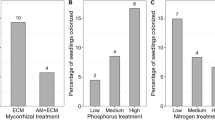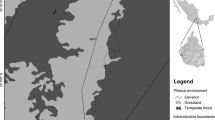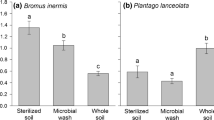Abstract
Little is known about the composition and function of the mycorrhizal fungal community in riparian areas, or its importance in competitive interactions between Populus fremontii, a dominant tree in southwestern United States riparian forests which forms arbuscular and ectomycorrhizas, and Tamarix ramosissima, an introduced tree species that has spread into riparian areas. The objectives of this study were to determine the mycorrhizal status of Tamarixand to evaluate the effect of mycorrhizal fungal inoculation on Tamarix growth and on the coexistence between Tamarix and Populus.Arbuscular mycorrhizal fungal colonization of Tamarix was very low in both field and greenhouse grown roots, but levels of colonization by dark septate endophytes were high. Fungal inoculation had little effect on Tamarix seedling growth in monoculture. When Populus and Tamarix were grown together in a greenhouse pot experiment, fungal inoculation reduced the height and biomass of Tamarix but had no effect on Populus. Fungal inoculation shifted coexistence ratios. When Tamarix and Populuswere grown together, Tamarixplants averaged 20 of pot biomass in the uninoculated control but only 5 of pot biomass in the inoculated treatment. These results indicate that Tamarix is non-mycotrophic and that in this greenhouse experiment inoculation altered patterns of coexistence between Populus and Tamarix.
Similar content being viewed by others
References
E B Allen M E Allen L Egerton-Warburton L Corkidi A Gomez-Pompa (2003) ArticleTitleImpacts of early- and late-seral mycorrhizae during restoration in seasonal tropical forest Mexico. Ecol. Appl. 13 1701–1717
E Barni C Siniscalco (2000) ArticleTitleVegetation dynamics and arbuscular mycorrhiza in old-field successions of the western Italian Alps Mycorrhiza. 10 63–72 Occurrence Handle10.1007/s005720000059 Occurrence Handle000089197600003
J R Barrow (2003) ArticleTitleAtypical morphology of dark septate fungal root endophytes of Bouteloua in arid southwestern USA rangelands Mycorrhiza. 13 239–247 Occurrence Handle10.1007/s00572-003-0222-0 Occurrence Handle14593517 Occurrence Handle1:STN:280:DC%2BD3srhsVOhtw%3D%3D Occurrence Handle000186280200001
J R Barrow R E Aaltonen (2001) ArticleTitleEvaluation of the internal colonization of Atriplex canescens (Pursh) Nutt. roots by dark septate fungi and the influence of host physiological activity Mycorrhiza. 11 199–205 Occurrence Handle000171251200004
J R Barrow P Osuna (2002) ArticleTitlePhosphorus solubilization and uptake by dark septate fungi in Fourwing Saltbush, Atriplex canescens (Pursh) Nutt J Arid Environ. 51 449–459 Occurrence Handle10.1006/jare.2001.0925
J R Barrow K M Havstad B D McCaslin (1997) ArticleTitleFungal root endophytes in Fourwing Saltbush, Atriplex canescens, on arid rangelands of southwestern USA Arid. Soil Res. Rehabil. 11 177–185
J D Bever (2003) ArticleTitleSoil community feedback and the coexistence of competitors: Conceptual frameworks and empirical tests New Phytol. 157 465–473 Occurrence Handle10.1046/j.1469-8137.2003.00714.x
J H Braatne S B Rood P E Heilman (1996) Life history, ecology, and conservation of riparian cottonwoods in North America R F Stettler H D Bradshaw P E Heilman SuffixJr T M E Hinckley (Eds) Biology of Populus and its Implications for Management and Conservation National Research Council of Canada Ottawa, Ontario, Canada 57–85
Brock J H 1994 Tamarix spp. (salt cedar), an invasive exotic woody plant in arid and semi-arid riparian habitats of western USA. In Ecology and Management of Invasive Riverside Plants. Eds. L C d Waal, L E Child, P M Wade and J H Brock. pp. 27–44. John Wiley & sons Ltd.
D E Busch S D Smith (1995) ArticleTitleMechanisms associated with decline of woody species in riparian ecosystems of the southwestern US Ecol. Monogr. 65 347–370
T R Cavagnaro F A Smith G Hay V L Carne-Cavagnaro S E Smith (2004) ArticleTitleInoculum type does not affect overall resistance of an arbuscular mycorrhiza-defective tomato mutant to colonisation but inoculation does change competitive interactions with wild-type tomato New Phytol. 161 485–494 Occurrence Handle10.1111/j.1469-8137.2004.00967.x
E M Christensen (1962) ArticleTitleThe rate of naturalization of Tamarix Am. Midl. Nat. 68 51–57
J R Cleverly S D Smith A Sala D A Devitt (1997) ArticleTitleInvasive capacity of Tamarix ramosissimain a Mojave Desert floodplain: the role of drought Oecologia. 111 12–18 Occurrence Handle10.1007/s004420050202 Occurrence HandleA1997XF86000002
G Cuenca Z De Andrade G Escalante (1998) ArticleTitleArbuscular mycorrhizae in the rehabilitation of fragile degraded tropical lands Biol. Fertil. Soils. 26 107–111
D G Evans M H Miller (1990) ArticleTitleThe role of the external mycelial network in the effect of soil disturbance upon vesicular arbuscular mycorrhizal colonization of maize New Phytol. 114 65–71
B L Everitt (1998) ArticleTitleChronology of the spread of Tamarisk in the central Rio Grande Wetlands. 18 658–668 Occurrence Handle000077733700014
J M Friedman W R Osterkamp M L Scott G T Auble (1998) ArticleTitleDownstream effects of dams on channel geometry and bottomland vegetation: regional patterns in the Great Plains Wetlands. 18 619–633 Occurrence Handle000077733700011
A C Gange D E Lindsay L S Ellis (1999) ArticleTitleCan arbuscular mycorrhizal fungi be used to control the undesirable grass Poa annua on golf courses? J. Appl. Ecol. 36 909–919 Occurrence Handle10.1046/j.1365-2664.1999.00456.x
J Goodwin (1992) ArticleTitleThe role of mycorrhizal fungi in competitive interactions among native bunchgrasses and alien weeds - A review and synthesis Northwest Sci. 66 251–260
W L Graf (1978) ArticleTitleFluvial adjustments to spread of Tamarisk in Colorado Plateau region Geol. Soc. Amer Bull. 89 1491–1501 Occurrence Handle10.1130/0016-7606(1978)89<1491:FATTSO>2.0.CO;2
W L Graf (1982) ArticleTitleTamarisk and river channel management Environ. Manage. 6 283–296 Occurrence Handle10.1007/BF01875060
J P Grime J M MacKey S H Miller D J Reed (1987) ArticleTitleFloristic diversity in a model system using experimental microcosms Nature. 328 420–422 Occurrence Handle10.1038/328420a0 Occurrence HandleA1987J385000055
M M Hart R J Reader J N Klironomos (2003) ArticleTitlePlant coexistence mediated by arbuscular mycorrhizal fungi Trends. Ecol. Evol. 18 418–423 Occurrence Handle10.1016/S0169-5347(03)00127-7
D C Hartnett G W T Wilson (1999) ArticleTitleMycorrhizae influence plant community structure and diversity in tallgrass prairie Ecology. 80 1187–1195 Occurrence Handle000081368500010
K Haselwandter D J Read (1980) ArticleTitleFungal associations of roots of dominant and sub-dominant plants in high-alpine vegetation systems with special reference to mycorrhiza Oecologia. 45 57–62 Occurrence Handle10.1007/BF00346707 Occurrence HandleA1980JQ10100010
J L Horton T E Kolb S C Hart (2001) ArticleTitlePhysiological response to groundwater depth varies among species and with river flow regulation Ecol. Appl. 11 1046–1059
Horton J S, Mounts F C and Kraft J M 1960 Seed germination and seedling establishment of phreatophyte species. USDA Forest Service Research Paper RM-48.
K M Jacobson (2004) Mycorrhizal associations in dryland riparian forests of the southwestern United States C L Cripps (Eds) Fungi in Forest Ecosystems: Systematics, Diversity, and Ecology New York Botanical Garden New York 275–280
W C Johnson (1992) ArticleTitleDams and riparian forests: case study from the upper Missouri River Rivers 3 229–242
A Jumpponen (2001) ArticleTitleDark septate endophytes - are they mycorrhizal? Mycorrhiza. 11 207–211 Occurrence Handle10.1007/s005720100112 Occurrence Handle000171251200005
A Jumpponen J M Trappe (1998) ArticleTitleDark septate endophytes: a review of facultative biotrophic root-colonizing fungi New Phytol. 140 295–310 Occurrence Handle10.1046/j.1469-8137.1998.00265.x
S Karrenberg P J Edwards J Kollmann (2002) ArticleTitleThe life history of Salicaceae living in the active zone of floodplains Freshwater Biol. 47 733–748 Occurrence Handle10.1046/j.1365-2427.2002.00894.x
J N Klironomos J McCune M Hart J Neville (2000) ArticleTitleThe influence of arbuscular mycorrhizae on the relationship between plant diversity and productivity Ecol. Lett. 3 137–141 Occurrence Handle10.1046/j.1461-0248.2000.00131.x
L M Kohn E Stasovski (1990) ArticleTitleThe mycorrhizal status of plants at Alexandra Fiord, Ellesmere Island, Canada, a high Arctic site Mycologia. 82 23–35 Occurrence HandleA1990CR53600004
R E Koske J N Gemma (1989) ArticleTitleA modified procedure for staining roots to detect VA-mycorrhizas Mycol. Res. 92 486–505
D J Lodge (1989) ArticleTitleThe influence of soil moisture and flooding on formation of VA-endo- and ectomycorrhizae in Populus and Salix Plant Soil. 117 243–253 Occurrence Handle10.1007/BF02220718
D J Lodge (2000) ArticleTitleEcto- or arbuscular mycorrhizas - which are best? New Phytol. 146 353–354 Occurrence Handle10.1046/j.1469-8137.2000.00668.x
M J Marler C A Zabinski R M Callaway (1999) ArticleTitleMycorrhizae indirectly enhance competitive effects of an invasive forb on a native bunchgrass Ecology. 80 1180–1186 Occurrence Handle000081368500009
T P McGonigle M H Miller D G Evans G L Fairchild J A Swan (1990) ArticleTitleA new method which gives an objective measure of colonization of roots by vesicular arbuscular mycorrhizal fungi New Phytol. 115 495–501
J Neville J L Tessier I Morrison J Scarratt B Canning J N Klironomos (2002) ArticleTitleSoil depth distribution of ecto- and arbuscular mycorrhizal fungi associated with Populus tremuloides within a 3-year-old boreal forest clear-cut Appl. Soil. Ecol. 19 209–216 Occurrence Handle10.1016/S0929-1393(01)00193-7
K K Newsham (1999) ArticleTitlePhialophora graminicola, a dark septate fungus, is a beneficial associate of the grass Vulpia ciliatassp ambigua New Phytol. 144 517–524 Occurrence Handle10.1046/j.1469-8137.1999.00537.x
D T Patten (1998) ArticleTitleRiparian ecosystems of semi-arid North America: diversity and human impacts Wetlands. 18 498–512 Occurrence Handle000077733700002
D J Read C P D Birch (1988) ArticleTitleThe effects and implications of disturbance of mycorrhizal mycelial systems Proc. Roy. Soc. Edin. Sec. B-Biol. Sci. 94 13–24
D J Read K Haselwandter (1981) ArticleTitleObservations on the mycorrhizal status of some alpine plant communities New Phytol. 88 341–352
B S Richter J C Stutz (2002) ArticleTitleMycorrhizal inoculation of big sacaton: implications for grassland restoration of abandoned agricultural fields Restor Ecol. 10 607–616 Occurrence Handle10.1046/j.1526-100X.2002.01041.x
S B Rood J M Mahoney (1990) ArticleTitleCollapse of riparian poplar forests downstream from dams in western prairies - Probable causes and prospects for mitigation Environ. Manage. 14 451–464
S B Rood J M Mahoney (1995) ArticleTitleRiver damming and riparian cottonwoods along the Marias River Montana. Rivers. 5 195–207
M L Scott G T Auble J M Friedman (1997) ArticleTitleFlood dependency of cottonwood establishment along the Missouri River, Montana, USA Ecol Appl. 7 677–690
P B Shafroth G T Auble J C Stromberg D T Patten (1998) ArticleTitleEstablishment of woody riparian vegetation in relation to annual patterns of streamflow, Bill Williams River, Arizona Wetlands. 18 577–590 Occurrence Handle000077733700008
S E Smith J D Read (1997) Mycorrhizal Symbiosis Academic Press San Diego
R R Sokal F J Rohlf (1995) Biometry W. H. Freeman and Company New York
M D Sprenger L M Smith J P Taylor (2001) ArticleTitleTesting control of saltcedar seedlings using fall flooding Wetlands. 21 437–441 Occurrence Handle000171281800013
M D Sprenger L M Smith J P Taylor (2002) ArticleTitleRestoration of riparian habitat using experimental flooding Wetlands 22 49–57 Occurrence Handle000174478700004
J C Stromberg B D Richter D T Patten L G Wolden (1993) ArticleTitleResponse of a Sonoran riparian forest to a 10-year return flood Gt. Basin Nat. 53 118–130
J C Stutz J B Morton (1996) ArticleTitleSuccessive pot cultures reveal high species richness of arbuscular endomycorrhizal fungi in arid ecosystems Can. J. Bot. 74 1883–1889
J P Taylor K C McDaniel (1998) ArticleTitleRestoration of saltcedar (Tamarix sp.)-infested floodplains on the Bosque del Apache National Wildlife Refuge Weed Technol. 12 345–352
J P Taylor D B Wester L M Smith (1999) ArticleTitleSoil disturbance, flood management, and riparian woody plant establishment in the Rio Grande floodplain Wetlands. 19 372–382 Occurrence Handle000080960700008 Occurrence Handle10.1007/BF03161769
J H Titus P J Titus R S Nowak S D Smith (2002) ArticleTitleArbuscular mycorrhizae of Mojave Desert plants West. North Am. Naturalist. 62 327–334
E W Heijden Particlevan der (2001) ArticleTitleDifferential benefits of arbuscular mycorrhizal and ectomycorrhizal infection of Salix repens Mycorrhiza. 10 185–193
M G A Heijden Particlevan der A Wiemken I R Sanders (2003) ArticleTitleDifferent arbuscular mycorrhizal fungi alter coexistence and resource distribution between co-occurring plant New Phytol. 157 569–578
M G A Heijden Particlevan der J N Klironomos M Ursic P Moutoglis R Streitwolf-Engel A W T.Boller I R Sanders (1998) ArticleTitleMycorrhizal fungal diversity determines plant biodiversity, ecosystem variability and productivity Nature. 396 69–72
J A Vozzo E Hacskaylo (1974) ArticleTitleEndomycorrhizal and ectomycorrhizal associations in 5 Populusspecies Bull. Torrey Bot. Club. 101 182–186
H M West A H Fitter A R Watkinson (1993) ArticleTitleThe influence of three biocides on the fungal associates of the roots of Vulpia ciliata spp. J. Ecol. 81 345–350
C A Zabinski L Quinn R M Callaway (2002) ArticleTitlePhosphorus uptake, not carbon transfer, explains arbuscular mycorrhizal enhancement of Centaurea maculosa in the presence of native grassland species Funct Ecol. 16 758–765 Occurrence Handle10.1046/j.1365-2435.2002.00676.x
E Zavaleta (2000) Valuing ecosystem services lost to Tamarix invasion in the United States H A Mooney R J Hobbs (Eds) Invasive Species in a Changing World Island Press Washington, DC 261–300
Author information
Authors and Affiliations
Corresponding author
Rights and permissions
About this article
Cite this article
Beauchamp, V.B., Stromberg, J.C. & Stutz, J.C. Interactions between Tamarix ramosissima (Saltcedar), Populus fremontii (Cottonwood), and Mycorrhizal Fungi: Effects on Seedling Growth and Plant Species Coexistence. Plant Soil 275, 221–231 (2005). https://doi.org/10.1007/s11104-005-1740-7
Received:
Accepted:
Issue Date:
DOI: https://doi.org/10.1007/s11104-005-1740-7




